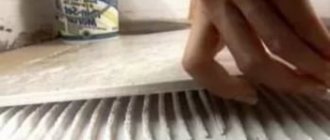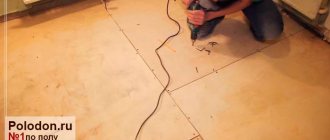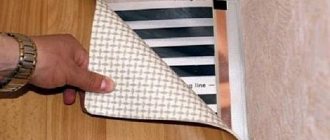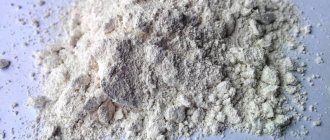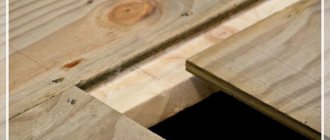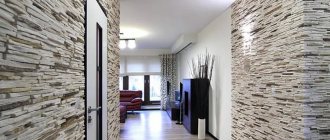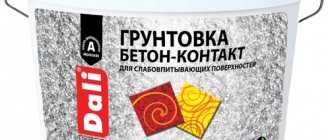We have been using gypsum-based sheet materials for a long time and very successfully. For the most part, we are, of course, talking about drywall - a common and easy-to-use construction and finishing material. However, at the moment, gypsum fiber sheets, or gypsum fiber sheets, are becoming increasingly popular. With the same scope of application, such materials have even more advantages and more attractive technical characteristics.
What is GVL: composition, scope of application
The abbreviation GVL stands for Gypsum Fiber Sheet. There are names like “gypsum fiber/gypsum fiber boards”. Plates, as a rule, are called materials of greater thickness and smaller size, although this is not a fact. Sometimes both terms are applied to the same material. Technical characteristics and requirements are standardized by GOST R 51829-2001, so the material is officially recognized. According to the standard, it can be used in the construction of private, public and industrial premises. Area of application: finishing and preparation for finishing walls, floors and ceilings. It is used for preliminary finishing, replacing “wet” processes - plaster, putty, pouring screed.
After pressing, the sheet is dried and brought to normal humidity (1.5%)
So GVL is one of the sheet finishing materials. Its composition includes cellulose fluffed into fibers, some additives that give the material certain properties (substances that increase the water resistance of the material are most often used). Gypsum is used as a binder. The components are mixed dry, and water is added to the finished mixture. The dough-like solution is used to form slabs that are fed into a press. After pressing, the sheet is brought to normal humidity (dried). Some companies (for example, Knauf) produce polished gypsum fiber boards. This kind of gypsum plasterboard for floors is too expensive, but for walls it is good because it does not need to be puttied before finishing.
Speaking specifically in relation to the floor, GVL is used for leveling under finishing floor coverings. It can be placed on joists or on a subfloor (solid or with cracks). Subject to certain conditions, installation on wooden floors and on screed (leveled, dry surface) is possible. Can be used in a floating floor as a dry screed material.
Material characteristics
Drywall must withstand the minimum permissible loads. The main supplier of drywall is Knauf. The sheets can withstand loads of 730 N. The weight of one sheet is 29 kg. Fire resistance of drywall is 20 min.
Knauf has developed products for interior decoration with fire protection.
Knauf panels in stock
Knauf FIRELINE has released a line of materials that include:
- raw panels;
- coated sheets.
The material has acoustic properties such as reflection, absorption, vibration. Fire-resistant products contain the following components:
- drywall;
- decorative surface (veneer, varnish, laminate);
- substructure.
Types and properties
According to the type of edge, gypsum fiber boards come with a straight edge (marked PC) or a folded edge (FK). Rebate dimensions: width 2.8-3.2 mm, depth 1.7-2.3 mm. For the floor, you can use either type, but with a rebate there will be no through seams. This means that there is no need to seal joints. However, the cost of such material is much higher, so gypsum fiber board with a straight edge is more often used.
GVL with straight and folded edge - two main types
As you know, gypsum is a hygroscopic substance. Therefore, conventional gypsum plasterboards are not used in areas of high humidity. There is a moisture-resistant modification for this. The letter “B” has been added to the front of the abbreviation. That is, VGVL is a moisture-resistant gypsum fiber sheet. It can be used in bathtubs, showers, etc. Outwardly, they do not differ from each other, so we are guided by the markings.
There is another type of gypsum fiber sheets - high density. Produced specifically for floors, marked GVL EP (floor element). Knauf has such a subtype. It costs a lot, but the geometry and strength characteristics are excellent. When using regular gypsum fiber board for the floor, as a rule, two sheets are taken, which are laid with offset seams. This gives a sufficient level of strength. As floor elements, gypsum fiber boards are recommended to be used in one layer - their strength is sufficient even in this version.
GVL dimensions and markings
According to GOST, gypsum fiber boards come in the following formats:
- width 500 mm, 1000 mm, 1200 mm;
- length 1500 mm, 2000 mm, 2500 mm, 2700 mm and 3000 mm;
- thickness 10 mm, 12.5 mm, 15 mm, 18 mm, 20 mm.
Deviation in width is no more than 3-4 mm, in length - 3 mm up to 2.5 m and 4 mm for longer slabs. Deviations in width are no more than 0.3 mm. The plan should be a rectangle. Permissible error (side bevel) - 4 mm.
Gypsum fiber board: standard sizes
Sheet marking displays all the data - moisture resistance, edge type and dimensions in millimeters. For example, GVL-PK 2000*1000*12.5 stands for ordinary (non-moisture resistant) gypsum fiber board with a straight edge. VGLV-FK - this means that the material is moisture resistant and the edge is folded.
Flammability category
Gypsum fiber sheets are classified as low-combustible materials. The cellulose is contained in gypsum, which does not burn or ignite. When in a flame, it does not support combustion. The classes according to the standards are:
- Non-flammable (class G1) and non-flammable (B1).
- When burning, they do not produce smoke (D1).
Fire-technical characteristics of GVL. It is classified as a non-combustible material - Low toxicity (T1). Only natural radionuclides are present.
So GVL is recommended for frame house construction as a cladding material. It is also good for leveling the floor in a wooden house - where the inability to burn is important.
Characteristics
A significant part of the characteristics of GVL is given within the framework - “from and to”. This is due to the fact that different cellulose and different percentages of its content can be used. If you are looking for a material with certain characteristics, view the materials from a specific batch. Each batch must be tested, all indicators are indicated in the accompanying documents. The characteristics of GVL are quite good, which, combined with a low price, makes them popular on the market. Here are the main technical characteristics:
- Strength and toughness are high - no less than 1000 and no more than 1250 kg/m³. This allows you to screw fasteners into the GVL. Specific resistance to pulling out screws is 40-50 n/m. This is two and a half times higher than that of drywall. But GVL requires special screws.
- Good soundproofing characteristics. Despite the sufficient density, sounds do not pass through well. Attenuation by 30-40 dB, depending on the thickness of the sheet. There are soundproofing three-layer boards based on GVL.
- Low thermal conductivity coefficient 0.22−0.35 W/m*ºС (for comparison, concrete 1.75 W/m*ºС). By using gypsum fiber board for the floor you reduce heating costs.
Comparative characteristics of gypsum fiber board with other types of sheet finishing materials - Bending strength 5.5 MPa. This is approximately the same characteristic of drywall. But it will not be possible to bend the GVL, since it is thick.
- Internal tensile strength 0.29-0.3 MPa. The indicator is average, the loads are preferably uniform, it reacts poorly to shock - it can crack if there is no dense base at the bottom.
- Modulus of elasticity - 2000-3000 MPa (for gypsum board 2000, for glass-magnesium sheets 3000-4000).
VGLV is one of the materials most resistant to high humidity and has a low cost. When water gets in or humidity increases, the stove absorbs it. As the humidity level drops, the moisture evaporates. This is not reflected in any way on the outside. That is, it is a durable, moisture-resistant material and can be used for interior decoration, even for wet rooms.
If we talk about the specific use of GVL on the floor, the material is not bad. Suitable for leveling, for laying along joists, can be laid on polystyrene foam, which increases the thermal insulation characteristics. This is one of the most inexpensive sheet materials, which explains its popularity.
GKL
To produce sheets of this type, gypsum (93%), cardboard (6%) and starch with water (1%) are used. The gypsum base is secured with sheets of cardboard on both sides, which provides additional resistance to stress.
Manufacturers produce 4 types of material:
- GKL standard. Designed for premises with standard operating conditions. It differs from others in its gray tint.
- GKLV - option with moisture protection. The primer with which the finished sheets are impregnated does not allow the base to absorb moisture, making the products suitable for finishing structures with high humidity. It differs from others in its green tint.
- GKLO is a fire-resistant option. The sheets are pink in color and are suitable for furnishing premises where increased fire resistance of surfaces is required.
- GKLVO is a mixed option for arranging saunas. It is characterized by increased resistance to open flame and moisture, has a green tint with red markings.
The sheets can vary in size as follows: thickness from 8 to 16 mm; width from 600 to 1200 mm; length from 2000 to 4000 mm.
The products are used to form ceilings, walls, partitions, arches and other structural elements.
Advantages:
- low cost;
- has excellent thermal insulation characteristics;
- ease of installation;
- the plasticity of the material allows the formation of curved structures;
- not subject to combustion. Plaster can only melt at high temperatures, but cardboard will burn. To eliminate this drawback, it is treated with special compounds in fire-resistant versions;
- sheets treated with moisture-resistant impregnations can be used in rooms with high humidity;
- to repair a separate section of the surface, it is not necessary to dismantle the entire sheet - it is enough to cut a piece of plasterboard to size and repair the defect;
- the material is suitable for installation in any type of premises for any type of finishing;
- does not contain allergens and other harmful substances that can evaporate during prolonged use;
- Suitable for masking various types of communications.
Flaws:
- plasterboard is very fragile, this disadvantage must be especially taken into account when transporting the material;
- low strength. The sheets cannot be used as a base for hanging heavy objects and furniture (maximum weight 25 kg);
- low sound insulation rates. For partitions it is necessary to use additional mineral wool boards.
General installation principles
It is possible and necessary to use GVL on the floor, but you must strictly follow the recommendations. In general, gypsum fiber sheet does not have very high strength. The short cellulose fragments reinforce the plaster to some extent, but the material is still quite brittle. Properly laid, it can withstand heavy loads - up to 2 tons per square meter. But the key words are properly laid out.
In one layer, and can withstand serious loads
Requirements for the base and installation features
GVL can be laid on either a continuous or discontinuous base. When laying on a solid base, it must be perfectly level. Requirements for the base - a difference of no more than 2 mm per 2 meters of length. Manufacturers insist on this and, if possible, it is better not to violate this recommendation.
One of the application options
In practice, it has been found that small smooth irregularities - an area of several square centimeters, a few millimeters in depth - are still acceptable. Manufacturers do not recommend it, but in practice it has been proven that GVL behaves more or less normally. The sheet may bend, repeating the shape of the notch. If there is linoleum, art vinyl or other soft covering on top, all this threatens is the appearance of a slight unevenness. It is better not to leave even such recesses under parquet or laminate, as the locks may come apart and there may be an unpleasant squeak.
And, even under a soft coating, unevenness cannot be left everywhere. If they are located where the load is applied, it is better to eliminate them. For example, on the aisle or where there will be a table leg, chest of drawers, bed, closet. There shouldn't be any irregularities here.
Second point. When laying on a loose base or on logs, GVL is placed on the floor either with increased density (floor elements) or moisture-resistant in two layers. When laying in two layers, the sheets are cut so that the seams of one layer do not coincide with the seams of the other. This is fundamental and the recommendation should absolutely not be violated.
The seams should not match
Third point. When laying GVL slabs on a hard, level floor (concrete), the ends are glued with PVA glue. When laying on a base that does not exclude movement (joists, for example), it is better to use elastic filler for the seams. One option is a sealant that remains flexible after drying. Apply it and immediately level the layer (you can use a gloved finger, for a better effect it can be moistened with water).
How to cut and fasten
You can cut gypsum fiber board with a hacksaw; for faster results, use an angle grinder (grinder) with a wood disc (ø 125 mm). In a straight line, you can break it just like drywall. To do this, cut one side (front) of the sheet, place a rule under the cut, tap the hanging part with your palm, and break it. The fracture site is far from perfectly level, so cutting gypsum fiber board onto the floor is hardly worth it. The cut has to be leveled and polished, and this takes no less time, and sometimes more, than working with a hacksaw.
Self-tapping screws for GVL need special ones - with a sharp conical head
The gypsum boards are secured to the floor with special self-tapping screws. They are called “by gypsum fiber”. They differ in that the cap has a sharper cone. This shape of the cap allows it to fit into a dense sheet without pre-drilling. The length of the screw must be at least 3 times the thickness of the slab. That's how you choose.
Key materials for interior decoration: SML, GVL and GLK, what is the difference
In appearance, GVL panels are very similar to ordinary sheets of plasterboard and glass-magnesium finishing materials. Standard plasterboard slabs are labeled as GLA. The inner part of the panels consists of gypsum, and the outer surface is made of cardboard.
Like the previous material, GLA is divided into several subgroups:
- GLKO – fire-resistant plates;
- GKLV – meaning “moisture-resistant plasterboard sheet”.
There are also combined boards containing polystyrene foam for insulation. The material is intended for external and internal work. Gypsum fiber and plasterboard have many similar properties: they are moisture resistant, fireproof and suitable for decorative cladding.
Magnesium glass sheets are very similar in their characteristics to GVL sheets.
To understand which is better - GVL or GLK, you need to familiarize yourself with the main differences between the panels. Thus, drywall consists of several autonomous layers of cardboard and gypsum, while gypsum fiber board is a solid fiber, which makes the sheets stronger and more reliable. There is another material with similar characteristics - LSU, the so-called glass-magnesium sheets, the main disadvantage of which is the content of chemical elements such as magnesium oxide and chloride.
If you choose between gypsum plasterboard or gypsum plasterboard, you need to take into account that fiber panels are better able to resist damage, because many who have worked with drywall note that the sheets are extremely fragile. In the case of gypsum fiber sheeting, you should not worry that it will easily lose its integrity in the event of a pinpoint impact
Another important advantage of gypsum fiber board is that, unlike gypsum plasterboard, it can be used to decorate floor coverings
If plasterboard is used to finish the walls, it is recommended to make as few joints as possible so that the surface does not lose strength. In the case of fiberglass, there is no such problem: the number of joints does not affect the reliability of the wall.
Other differences in materials are shown in the table:
| Criterion | GVL | GLK |
| Ability to bend | It bends very badly | Easily make complex curved shapes |
| How does it behave when cutting? | Can be cut in any way, because the edges remain smooth | It crumbles and cracks at the cut points |
| Resistance to temperature changes | Does not change its properties even when frozen | Doesn't like changes |
| Humidity resistance | They tolerate exposure to high humidity well, especially if moisture-resistant GVL or GLA is used for walls. | |
| Installation features | Can be attached directly to the surface or to the sheathing |
It should also be taken into account that the cost of gypsum plasterboard sheets for walls is higher than the price of conventional plasterboard panels. When decorating a room, many people prefer to combine slabs depending on the surface.
Method of laying gypsum fiber board on logs
GVL on the floor along the joists is taken with increased density (from Knauf this is Super Floor) or two layers of ordinary moisture-resistant material are laid, spaced apart from the seams (they are shifted so that the seams do not coincide). In any case, there are two ways to make a gypsum fiber board floor using joists:
- Place gypsum fiber sheets directly on the joists. The installation step of the logs depends on the thickness of the slabs. The thicker the GVL, the larger the pitch of the lag. Minimum distance 30 cm, maximum 50-60 cm.
Making a base from logs - Make a subfloor (flat) along the joists, and then lay gypsum fiber boards on it. The advantages of this option are that logs can be installed in increments of 60-80 cm, which reduces the cost of timber. But you need a floorboard. And although the subfloor may not be continuous, the board must be dry, even and planed, since the base must be level.
When laying gypsum fiber boards directly on logs, the pitch of the beams and the dimensions of the sheets should be selected so that the edges of the slabs rest on the beams. They are fastened with self-tapping screws, retreating at least 1.5 cm from the edge. The fasteners are installed in the intermediate beam (if there is a support under the sheet) with the same spacing. If necessary, the gaps between the logs are filled with heat-insulating or sound-proofing materials. Depending on the design of the floor, they are either installed vertically or placed on a leveled base.
What are gypsum fiber sheets, key features of the material
GVL is one of the most popular and in demand materials for interior decoration today. The abbreviation stands for gypsum fiber sheet, and the material itself is a durable panel used for cladding walls or organizing floor screeds.
The advantages of gypsum fiber are strength, ductility and uniform structure. Note! The sheets are considered environmentally friendly because GVL is a building material consisting of 80% gypsum and 20% cellulose. The main difference from a regular sheet of drywall is its uniform structure without a shell.The main advantages of gypsum fiber are high strength and ductility characteristics, as well as a uniform structure. Thanks to this, it will be possible to hammer nails into the sheets, just like into wood. The presence of only natural components in the composition allows you to preserve and maintain a special microclimate in the room, because the sheets absorb excess moisture and then release it.
If you think about what GVL is in construction, then first of all it is worth noting that it is a convenient material suitable for finishing various surfaces.
When purchasing, be sure to pay attention to the presence of various marks on the packaging:
- “Ш” means that the sheets have undergone a grinding process;
- “NS” – marked on unpolished surfaces.
GVL in construction is an excellent material for finishing ceilings, walls and even floors.
You should choose one of the options based on the purpose of use. For example, if you plan to carry out finishing work for painting or wallpaper, it is better to choose sanded sheets, but when laying tiles on gypsum fiber board, you can use unsanded material.
Another fact that needs to be taken into account is the design of the joints. If you want the joints to remain invisible, it is better to choose sheets marked with the letters “FK”, because in this case the plates are supplemented with a special chamfer for an invisible joint. In the situation with ordinary sheets, reinforcing tape is used to minimize the appearance of seams.
Dry screed with GVL sheets
This technique was developed by Knauf, and a high-density tongue-and-groove gypsum board was developed for it. This material is called Super Floor. The essence of the method is that fine expanded clay (expanded clay sand) is poured onto a base (any, of any degree of curvature). Expanded clay is leveled, and floor elements made of gypsum fiber board are placed on it. The finishing floor covering can be laid on this base. You can make your own insulated floor very quickly and conveniently. In addition, the technique does not create significant loads on the floor.
GVL on the floor: dry screed
Instead of expanded clay sand, you can use regular construction dry sand. You cannot mix different materials or different fractions, as sooner or later they will shrink. And when laying gypsum fiber board on the floor, a flat base without dips is required. So it’s better not to allow drawdowns.
Conclusion
From the article you learned that gypsum fiber sheets have higher characteristics than plasterboard. In addition, the scope of application of this material is wider, which makes it an excellent alternative to gypsum board. You can get additional information about the properties of gypsum fiber sheets from the video in this article.
If this didn’t seem enough, ask questions in the comments, and I will definitely answer you.
Plasterboard systems, Finishing materials
If you want to express gratitude, add a clarification or objection, or ask the author something, add a comment or say thank you!
GVL on a concrete base
Concrete screed is a reliable foundation, but cold. If you don't heat it, the floor will be very cold. Residents of the first floors of high-rise buildings and private houses know this. The problem is solved by using a floating floor with improved thermal insulation characteristics. There is a traditional solution: put a layer of insulation and pour another layer of screed on top. But this is too heavy and will take a lot of time. You can make a dry screed - it's faster, easier and cheaper.
Comparison of sound insulation characteristics of various materials
How to make a dry GVL screed on a concrete base? A layer of insulation is placed on the concrete, and sheet material is placed on top. It is better to use polyurethane foam or high-density polystyrene foam (at least 35 kg/m³) as insulation. Why not mineral wool? Because its thermal insulation characteristics are several times lower. This means that instead of 3-5 cm of polyurethane foam, 15-20 cm of cotton wool will be required. Few people would want to raise the floor to such a height.
One of the sheet material options for dry floor screed is gypsum fiber boards. GVL is ideal for flooring, as it itself has increased heat-insulating properties and also dampens sounds well. GVL flooring is a good base for laminate, linoleum, carpet and other coverings.
Key points from the practical use of gypsum fiber board floors on concrete
When laying gypsum fiber board on a rigid base, it should lie tightly. There should be no voids or protrusions underneath. That is, the concrete base must be level and smooth. GVL is laid on concrete. Fasten along the perimeter in increments of 50-60 cm, install clamps. In general, you can use a composition like Rotband based on gypsum. It will both fill/even out minor unevenness and keep the sheets in place.
If it is necessary to improve the thermal insulation characteristics, extruded polystyrene foam (EPS) or polystyrene foam is placed on the concrete floor. You can simply lay it down without attaching it. But to prevent the insulation boards from creaking, they must lie tightly. If there are small irregularities, they can be filled with the same glue. It is applied under the slab using a notched trowel. The height of the tooth depends on the irregularities that need to be leveled.
Fasten two layers of gypsum fiber board together
The thickness of the foam is selected based on the requirements and structure of the cake. If there are two layers, they are laid with the seams staggered (so that the seams do not coincide). So that they do not rub or creak, or move out of place during operation, they can be fastened together. For this use:
- Tile adhesive. A thin layer is applied and trimmed with a notched trowel (4 mm). The glue is not for gluing, but for filling voids that are formed due to the fact that EPS is often in the form of a “boat”, that is, the edges are raised when compared to the middle.
- Mounting umbrellas. Such a length that only the foam sheets will stick. The floor should remain floating. There should be no fixation to the base.
- Double sided tape.
- Tie the layers with polyurethane foam. A good option that allows you to level out the imperfection of the EPS geometry. But the foam must be applied in a very small layer and it must have a slight expansion.
For floors, two layers of GVL are usually used. They are laid with seams spaced apart. The layers are fastened with self-tapping screws. The thickness of the gypsum plasterboard for the floor depends on the planned load. Typically, slabs of at least 12.5 mm thickness are used. If the geometry of the material is not ideal and there are differences in height, so as not to sand, you can use the same gypsum-based glue.
Characteristics
GVL: what is it and how does it differ from gypsum board? Gypsum fiber sheet gets its name from the two materials from which it is made - gypsum and cellulose fibers. As a result of pressing this mixture, a high-strength building material is obtained.
Characteristics of GVL sheet:
- Strength, viscosity and density (withstands force up to 100 kg per 1 sq. cm).
- Excellent thermal insulation properties due to low thermal conductivity coefficient.
- Good soundproofing qualities, directly dependent on the thickness of the sheet.
- Fire resistance. The material cannot ignite on its own and does not spread flame, therefore, in accordance with GOST, it is often used for finishing industrial premises and for fire protection of structures.
- Frost resistance. Thanks to this quality, it can be used to decorate an unheated loggia.
- Environmental friendliness. The material does not emit harmful substances and is perfect for residential premises.
- Moisture-resistant GVL sheets are successfully used in the kitchen and bathrooms.
When there is high humidity in the room, gypsum fiber absorbs excess moisture; when there is a lack of moisture in the air, it can release it.
Several disadvantages of gypsum fiber sheets:
- The main disadvantage of the material is its weight. Compared to drywall, it is heavy. GVL 10 and 12.5 mm thick weigh 36 and 45 kg, respectively.
- Gypsum fiber cannot be bent; it cannot withstand such deformations.
- The material costs 2 times more than drywall.
Gypsum fiber sheets are produced by many foreign manufacturers, but the most common products on the Russian market are those from Knauf. It has two types of sizes corresponding to GOST:
- Standard sheet – 2.5 × 1.2 m, thickness 10 or 12.5 mm.
- Small-format sheet – 1.5 × 1 m, the thickness is the same.
Sheet sizes are selected based on the purpose for which they will be used.
In addition to ordinary sheets, Knauf produces elements for dry floor screed "KNAUF-superfloor", which have a size of 1.2 × 1.2 m and a thickness of 2 cm. They are slabs obtained by gluing two sheets of GVLV with an offset, behind As a result, folds 5 cm wide are formed on two adjacent sides of each element.
Technical characteristics of gypsum fiber sheets and production technology must comply with the requirements of GOST R 51829-2001. When buying material, you need to make sure that it is not a fake: it must have a certificate of conformity, each sheet must have a marking indicating the size, type of edge, GOST.
Laying gypsum fiber board on a wooden floor
In principle, everything has already been said above. If the wooden floor is flat, you can lay gypsum fiber board without fear. It allows moisture to pass through normally, so the wood is not in danger of rotting. If the floor is uneven (which usually happens), it is best to dismantle it and lay the gypsum fiber board along the joists. Or make a subfloor. If this is not possible for some reason, GVL can also be placed on a wooden floor. There is a possibility - eliminate the unevenness with a plane, fill the cracks. If that doesn't work, there is an emergency option.
A gypsum fiber sheet will help level this out.
We take a primer for gypsum mixtures and cover the floor in several layers. All cracks should be filled with construction foam with good adhesion and leveled with the surrounding floor level. We mix good quality gypsum plaster as for plaster (thick dough). We take a wide spatula and level the floor - apply plaster. In some places - to scrape, in others - until the unevenness is filled. Let's take a big rule and align everything to one level. When dry, apply two layers of GVL.
Polystyrene board
What is polystyrene board? To be precise, this is not a polystyrene plate, but a plate made of extruded gas-filled (foamed) polystyrene foam.
Thanks to extrusion (extrusion technology during manufacturing), the extruded polystyrene foam board does not have internal cells. This gives polystyrene foam boards high compressive strength, low thermal conductivity (0.030-0.034), minimal water absorption (0.3%) and it has a low specific gravity (25-40 kg/m 3 ).
- Polystyrene board does not allow heat to pass through, which means it is a good insulator;
- Polystyrene board is very compressive and therefore suitable for loaded floors;
- Polystyrene board practically does not absorb water, which makes it a good vapor barrier.
- Low specific gravity makes it possible to make the design of a heated floor as light as possible.
All these characteristics allow the use of extruded polystyrene foam boards as the basis for a heated floor system. The simplified name is polystyrene board.
Let's return to the polystyrene heated floor system.
In essence, a polystyrene heated floor system is a water heated floor laid on polystyrene slabs with special channels for pipes. Let’s look at this “layer cake” of the polystyrene underfloor heating system.
How to lay tiles on a GVL floor
In order for the gypsum plasterboard tiles to hold well and for cracks to not appear, the base under the gypsum fiber must be absolutely flat and strong. If these are boards, there are no gaps, cracks or sagging. If the floor is made using joists, the thickness of the layers should be sufficient to prevent even the slightest deflection during loading and walking.
Installing GVL on the floor under tiles is a possible option
Since tiles are usually laid in rooms with high humidity, additional waterproofing is required. It is recommended to use KNAUF-Flachendicht or other mastics and rubber paints.
When laying ceramic tiles on GVL, you need to use elastic adhesive for unstable or difficult substrates. Make the layout so that the tile seam and the joint of the sheets do not coincide. It is desirable that the joint of the slabs be in the middle of the tile. With this approach, problems and cracks do not arise.
Features of working with moisture-resistant drywall
GVL is suitable for work in rooms with aggressive environments:
- kitchens;
- bathrooms;
- showers;
- swimming pools.
The joints and edges of the panels are treated with moisture-proof compounds. Impregnation is carried out before finishing so that moisture does not get inside the material.
Making a frameSource izgipsokartona.com
Installation work begins with the manufacture of a frame, for which metal profiles are used.
Let's look at the GVL sheet and what it is for the kitchen and bathroom. Knauf offers decor and design options that are specially designed for wet use. Complete Knauf Dry Construction systems for interior finishing are recognized as advanced.

